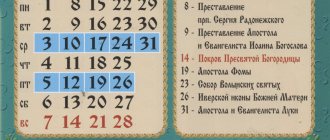Gregorian calendar ("new style")
Introduced in 1582 AD. Pope Gregory XIII so that the day of the vernal equinox does not “slide” towards summer, but corresponds to a specific day (March 21). This day is used to determine the date of Easter, the correctness of which is very important for the church.
For a more accurate approximation to the real length of the year, years whose number is a multiple of 100 are taken as non-leap years (except for those that are multiples of 400); For example, 2000 was a leap year, and 1900 was a non-leap year.
Earlier dates are converted using standard rules for Gregorian leap years.
Attention! Our converter can convert up to 2400 g.
Day of the week
The day of the week corresponding to a given date can be calculated as follows. You need to calculate JD for this date at 0 o'clock, add 1.5, then divide the result by 7. The remainder of the division will correspond to the day of the week, namely: 0 - Sunday, 1 - Monday, 2 - Tuesday, 3 - Wednesday, 4 - Thursday, 5 - Friday, 6 - Saturday. The sequence of the days of the week was not disrupted by the reform of the Gregorian calendar. So, in 1582, October 4th (Thursday) was followed by October 15th (Friday).
Example 5
Find the day of the week for the date June 30, 1954.
1954 June 30.0 corresponds to the Julian day JD = 2434923.5 2434923.5 + 1.5 = 2434925 The remainder when dividing 2434925 by 7 is 3. Hence the day of the week is Wednesday.
Julian calendar ("old style")
Introduced in 46 BC. Julius Caesar and totaled 365 days; Initially, every third year was a leap year. The incorrect number of leap years again led to an accumulation of errors, so this rule was corrected by Emperor Augustus: from 8 BC. and until 8 AD. additional days of leap years were skipped, and after that every fourth year became a leap year.
Attention! Our converter converts earlier dates using standard rules for Julian leap years.
Day of the year
Serial number of the day in the year N
can be calculated using the following formula.
N = INT((275 * M) / 9) - K * INT ((M + 9) / 12) + D - 30
where M
– month number,
D
– day of the month, and:
K = 1 for leap year K = 2 for regular year
N
accepts integer values from 1 for January 1 to 365 (or 366 for leap years) for December 31.
Example 6
Find the day of the year for the date November 14, 1978
Ordinary year, M = 11, D = 14, K = 2 We get N
= 318.
Roman version of the Julian calendar
Introduced around 750 BC. Due to the fact that the number of days in the Roman calendar year was changed by the arbitrary decision of the priests, dates before 8 AD. are not accurate and are presented for demonstration purposes.
The chronology was carried out from the founding of Rome (ab Urbe condita) - 753/754 BC.
Attention! Our date converter shows dates up to 753 BC. are not calculated, because in the Roman calendar have no historical meaning.
Month names
The names of the months of the Roman calendar are agreed upon definitions of the word mensis - month: m. Januarius; m. Februarius; m. Martius; m. Aprilis; m. Majus; m. Junius; m. Julius; m. Augustus; m. September; m. October; m. November; m. December.
God of time - Janus two-faced and Maya - goddess of fertile land
The Romans, like us, had 12 months (or rather, the modern world borrowed these months from them, often with names), but their year began in March. The months got their name from the names of gods, people, holidays and just numbers:
| № | Modern name | Roman name | in honor of: |
| 11 | January | Ianuarius | Janus - God |
| 12 | February | Februarius | Februa - festival |
| 1 | March | Martius | Mars - God |
| 2 | April | Aprilis | ? |
| 3 | May | Maius | Maia - Goddess |
| 4 | June | Iunius | Iuno - Queen of the Gods |
| 5 | July | Iulius/Quinctilis | Iulius - Caesar / 5 (quinque, fifth) |
| 6 | August | Augustus/Sextil | Augustus – Emperor / 6 (sex, sixth) |
| 7 | September | September | 7 (septem, seventh) |
| 8 | October | October | 8 (octo, eighth) |
| 9 | November | November | 9 (novem, ninth) |
| 10 | December | December | 10 (decem, tenth) |
Days of the month
The date within the month was determined by the phases of the moon. The first day of the month (new moon) was called Kalendae; The 5th or 7th day of the month (second phase of the Moon) was called Nonae; The 13th or 15th day of the month (third phase, full moon) was called Idus. The Nones were on the 7th and the Ides on the 15th day occurred in March, May, July and October, in the remaining months the Nones were on the 5th and the Ides on the 13th. For example, August 22, 80 AD. designated as follows: eleven days before the September Kalends (ante diem XI Kalendas Septembres).
The first days of the month were determined by counting the days from the upcoming Nons, then, when the Nones passed, from the Ides, and the last days were determined from the future Kalends. If the day fell on Kalends, Nona or Ides, then the name of this day was put in abl.pl., for example: February 1 - Kalendis Februariis, March 15 - Idibus Martiis, April 5 - Nonis Aprilibus. The day immediately preceding the Kalends, Nones or Idams was designated by the word pridie (on the eve) with acc.: January 31 - pridie Kalendas Februarias, March 14 - pridie Idus Martias, April 4 - pridie Nonas Apriles.
Days of the week
Although the division into weeks of seven days dates back to ancient Babylon, seven days of the week became the standard around the 3rd century AD. The days of the week were named after celestial bodies:
| № | Day | Roman Day | in honor of: |
| 1 | Monday | dies Lunae | The Moon |
| 2 | Tuesday | dies Martis | Mars |
| 3 | Wednesday | dies Mercurii | Mercury (Mercury) |
| 4 | Thursday | dies Iovis | Jupiter (Jupiter) |
| 5 | Friday | dies Veneris | Venus (Venus) |
| 6 | Saturday | dies Saturni | Saturn |
| 7 | Sunday | dies Solis | The Sun |
The Julian date is the number of days that have passed since noon on January 1st, 4713 BC. This date is arbitrary and was chosen by historians only to harmonize various chronology systems.
The Lilian date is an astronomical method of measuring time that counts the number of days that have passed since the introduction of the Gregorian calendar (00:00:00 October 15, 1582).
The date changes at midnight Coordinated Universal Time, or UTC. The Lilian date of October 15, 1582 has a serial number of 1. The Lilian date can be obtained from the Julian date by subtracting 2,299,160.5 and eliminating the decimal fraction from the result. (c)The basis of the script was taken from the currently non-existent site https://www.24hourtranslations.co.uk/dates.htm
Months code
Counting by knuckles: “bump” - 31 days, “hollow” - 30 days (for February 29 or 28 days)
| № | Month | Amount of days |
| 1 | January | 31 |
| 2 | February | 28 (in leap years - 29) |
| 3 | March | 31 |
| 4 | April | 30 |
| 5 | May | 31 |
| 6 | June | 30 |
| 7 | July | 31 |
| 8 | August | 31 |
| 9 | September | 30 |
| 10 | October | 31 |
| 11 | November | 30 |
| 12 | December | 31 |
Rule for remembering the number of days in a month | code
There is a simple rule for remembering the number of days in a month - the “rule of dominoes”.
If you put your fists together in front of you so that you can see the backs of your palms, then by the “knuckles” (finger joints) on the edge of the palm and the spaces between them you can determine whether a month is “long” (31 days) or “short” (30 days, except February). To do this, you need to start counting the months from January, counting the dominoes and intervals. January will correspond to the first domino (long month - 31 days), February - the interval between the first and second dominoes (short month), March - domino, etc. The next two consecutive long months - July and August - fall exactly on the adjacent knuckles of different hands (the space between the fists does not count).
There is also a mnemonic rule "Ap-yun-sen-no". The syllables of this word indicate the names of months consisting of 30 days. It is known that February, depending on the specific year, contains 28 or 29 days. All other months contain 31 days. The convenience of this mnemonic rule is that there is no need to “recount” the knuckles.
Why was the new style introduced?
The Gregorian calendar provides a much more accurate approximation of the actual length of the year. Over the centuries, astronomical days gradually shifted to which agricultural work and religious holidays were tied: spring and autumn equinox, etc.
Pope Gregory XIII
The main reason for the intervention of the Pope and the adoption of a new calendar was the gradual shift in relation to the Julian calendar of the day of the vernal equinox, by which the date of Easter was determined. Before Gregory XIII, Popes Paul III and Pius IV had already tried to clarify the calendar, but they were not successful. The preparation of the reform, at the direction of Gregory XIII, was carried out by the astronomers Christopher Clavius and Aloysius Lilius.
In 1583, Gregory XIII sent an embassy to Patriarch Jeremiah II of Constantinople with a proposal to switch to a new calendar. At the end of 1583, at a council in Constantinople, the proposal was rejected as not complying with the canonical rules for celebrating Easter.
The transition to the Gregorian calendar entailed the following changes:
- the new calendar immediately at the time of adoption shifted the current date by 10 days and corrected accumulated errors;
- In the new calendar, a new, more precise rule about leap years began to apply - a leap year, that is, contains 366 days, if:
- the year number is a multiple of 400 (1600, 2000, 2400);
- other years - the year number is a multiple of 4 and not a multiple of 100 (... 1892, 1896, 1904, 1908...);
- The rules for calculating Christian Easter were modified.
- Over time, the Julian and Gregorian calendars diverge more and more, by three days every 400 years.
conclusions
Having begun to answer the question: what is the Kaledy Dar or the Slavic calendar, we received even more questions. Of course, it would be nice to write: here it is, such an accurate and beautiful calendar. Use it like our ancestors did thousands of years ago. But unfortunately, so few sources have reached us that could provide comprehensive answers. Imagine that a flood will come again (?) (the poles will change, etc.) and will sweep away all the achievements of civilization. Only some stone blocks will remain here and there. No books, no computers. Our distant descendants in three to four thousand years will find burials and will judge the development of our civilization by the decorations. Well, and, of course, study rock paintings, the same ones that we are now studying ourselves. And stone calendars.
I will be glad if my research made you think about seemingly ordinary phenomena. Sometimes it's more important than getting an answer.
Lada Frolova
The process of switching to the Gregorian calendar
In a number of cases, the transition to the Gregorian calendar was accompanied by serious unrest. For example, when the Polish king Stefan Batory introduced a new calendar in Riga in 1584, local merchants rebelled, claiming that a 10-day shift would disrupt their delivery times and cause significant losses. The rebels destroyed the Riga church and killed several municipal employees. It was possible to cope with the “calendar unrest” only in the summer of 1589.
In some countries that switched to the Gregorian calendar, the Julian calendar was subsequently resumed as a result of their annexation with other states.
In Britain , which switched to the Gregorian calendar by decision of King George II on September 2, 1752, the date had to be moved forward not by 10, but by 11 days, since a whole century had already passed since the new calendar came into force in continental Europe and another extra one had accumulated day. After the 2nd, September 14th came immediately. The subjects were unhappy with the decision that made them older. Protests were observed in the country under the slogan: “Give us back our eleven days!”, which is present in particular in one of the engravings of the “Elections” series created by William Hogarth. Riots broke out from time to time, sometimes leading to casualties, for example in Bristol.
Engraving by William Hogarth with the slogan "Give us back our eleven days!", 1755.
The introduction of the new calendar also had serious financial consequences. In 1753, the first full year according to the Gregorian calendar, bankers refused to pay taxes, waiting until the required 11 days after the usual closing date of March 25. As a result, the “new financial year” in the UK began only on April 6. This date has survived to this day, as a symbol of the great changes that occurred 250 years ago.
In Sweden they decided to switch to the new calendar gradually, abolishing leap days from 1700 to 1740.
In 1700, the first leap day was abolished. Then the war started and they forgot about the translation. Thus, the country lived according to its own Swedish calendar. In 1711, Charles XII recognized this as impractical and decided to return to the old style and add 2 days in February. Therefore, in Sweden it was February 30, 1712. It was not until 1753 that a new style was introduced. Moreover, February 17 was immediately followed by March 1. Difference between Julian and Gregorian calendar dates
| Difference, days | Period (Julian calendar) | Period (Gregorian calendar) |
| 10 | October 5, 1582 – February 29, 1700 | October 15, 1582 - March 11, 1700 |
| 11 | March 1, 1700 - February 29, 1800 | March 12, 1700 – March 12, 1800 |
| 12 | March 1, 1800 – February 29, 1900 | March 13, 1800 – March 13, 1900 |
| 13 | March 1, 1900 - February 29, 2100 | March 14, 1900 – March 14, 2100 |
| 14 | March 1, 2100 - February 29, 2200 | March 15, 2100 – March 15, 2200 |
| 15 | March 1, 2200 - February 29, 2300 | March 16, 2200 – March 16, 2300 |
Some countries adopted the new style piecemeal, for example the various cantons of Switzerland adopted the calendar reform for almost 120 years!
Revolutionary France introduced its own calendar, “republican”, based on the 1792 revolution. It was also based on Gregorian, but with its own characteristics. In this calendar, weeks became decades, with 10 days per decade. The month consisted of three decades. The year consisted of 12 months and 5 non-monthly holidays (6 in leap years).
The transition to the Gregorian calendar in Alaska after its sale to Russia was unusual, since there it was combined with a change in the date line. Therefore, after Friday October 5, 1867, according to the old style, there was another Friday, October 18, 1867, according to the new style.
Japan decided to switch from the traditional (lunar-solar) calendar to the Gregorian calendar , so that the next day after the “second day of the twelfth month of the fifth year of Meiji” became January 1, 1873, as a result of which the Japanese calendar was brought into line with the calendar major Western powers (with the exception of Russia). However, the nengo system continues to be used in official documents. For example, the year 1868 might be written as the first Meiji year, 1912 as Taisho 1, 1926 as Showa 1, 1989 as Heisei 1, and so on. In common practice, however, chronology is used from the Nativity of Christ according to the “Western calendar” (seireki), which became the main one in Japan during the 20th century.
Korea adopted the Gregorian calendar on January 1, 1896. Although, according to the accepted calendar, the correct numbering of months and days was established, in the continuation of 1895-1897 the old numbering of years continued according to the first year of the Joseon dynasty, according to which 1896 of the Gregorian calendar corresponded to 1392 of Joseon. Then, the counting of years from various historical events was used, until, from 1962, a counting of years identical to the Gregorian calendar was established. In North Korea, on July 8, 1997, a new “Juche” calendar was adopted, which is based on the rules of the Gregorian calendar, but the beginning of which is 1912, the year of birth of Kim Il Sung.
The Republic of China officially adopted the Gregorian calendar upon its proclamation on January 1, 1912. With the unification of China under the Kuomintang in October 1928, the National Government decreed that the Gregorian calendar would be used from January 1, 1929. However, China retained the Chinese tradition of numbering months, and the first year of the proclamation of the Republic of China, 1912, was designated as the beginning of the calendar. This system is still used in Taiwan, which considers itself the successor to the Republic of China. After the proclamation of the People's Republic of China in 1949, mainland China continued to use the Gregorian calendar, but the numbering and chronology introduced by the previous government was canceled and correspondence was established with the chronology from the Nativity of Christ, adopted both in the USSR, friendly to China, and in the West.
In Russia (in the territory under Soviet control), the Gregorian calendar was introduced by a decree of January 26, 1918 of the Council of People's Commissars, according to which in 1918 January 31 would be followed by February 14. In the territories of the former Russian Empire, which were under the control of other state entities that arose after the fall of the Provisional Government, the dates of the official introduction of the new style differ. Thus, the Provisional Siberian Government introduced a new style by decree of August 31, 1918, deciding to consider the day of October 1, 1918 as the day of October 14, 1918.
Later in the USSR, the practice was established of calculating years from the revolution of 1917 (for example, 1987 was the “70th year of the Russian Revolution”), but the main calendar remained the Gregorian calendar, the phrase “from the birth of Christ” was replaced by “AD” or “BC "
Greece was one of the last to switch to the Gregorian calendar in 1924, Turkey in 1926 and Egypt in 1928. Only Ethiopia and Thailand have not yet switched to the Gregorian calendar.
Calendar of the ancestors of the Slavs
Wikipedia states that the origin of the word “calendar” has Latin roots. "Kalendae" is the first day of the month. Previously, debt payments were due on Kalends. Therefore, as they explain to us, “accounting books” gradually became a calendar in the modern sense.
Another opinion is that the origin of the word is from “Kalada Dar” and it then spread throughout the world and “reached” Ancient Rome. The following conclusions support this opinion: in Latin “debt” is “debitum”. Do you recognize the familiar “debit”? The Latin word for the book is libra or libellus. Note – “note”, “album” or “literae”. The ancient Romans also had a separate word to denote the concept of loan - “faeneror”. Why then did the notes about the debt, which was recorded and required to be repaid, begin to be called precisely by the first day of the month - “calends”? It turns out that “calendarium” and loans are a rather illogical explanation for the origin of the word “calendar” in its subsequent understanding.
Read about what was predicted for us in 2021 along with clairvoyants and astrologers in the article “Predictions for 2021 for Russia...”
It's time to take stock of the year...
It seems more logical to originate from the gift of Kalyada. Let's consider this statement. Kruglolet Chislobog - another name for the Kalada of the Gift, is based on the 9 and 16 number counting system. Also for the Slavs, the sacred number is 3.
Remember Russian folk tales: the three-headed snake; stone near three roads; distant lands; Far Far Away kingdom; forty forty.
Over the tens of thousands of years of Kalyada, Dar “did not run” ahead and “did not lag behind” even a day! The reason for the accuracy of the Circlet is that it is based on the mathematical model of the Universe. It takes into account the galactic location of the Earth and its axial centralization.
The calendar is displayed by Runes. Sorokovniki is a month of forty days. Fortieth - the first was designated by one Rune, and subsequent ones - by a combination of the Rune of the first Fortieth with the second Rune, which designated part of the rotation of the Earth around Yarila (Sun).
One cycle of the Earth's rotation around Yarila was Summer. If we multiply 40 (days) by 9 (months), we get 360 days. The week consisted of nine days - 9 days.
360 degrees in a circle - maybe this is where they originate? And 360 seconds in an hour?
“Summer” has many concepts in Russian. “How old are you?”, not “years”. And also: chronicle, chronology, in years (middle-aged), in youth, sink into oblivion...
“Let” means to fly without support, and “o” means a circle, “summer” means to fly in a circle.
Dates in the Chronicles were written in letters, not numbers, as Peter the Great ordered.
So, here is how the years were calculated (at the time of the introduction of the calendar from the Nativity of Christ, i.e. 1700):
Summer 7208 from the Creation of the World in the Star Temple;
12708 from the Great Cold;
44244 from the Creation of the Great Colo of Russia;
106478 from the Founding of Asgard of Iria;
111813 from the Great Migration from Daariya;
And further, until Summer 604,074 from the Time of Three Suns...
Let us remember that this is as of 1700, i.e. We add to these dates the 320 years that have passed since Peter’s reform.
In March 2021, the 7528th summer begins from the Creation of the World in the Star Temple.
Religions
Since 1923, most local Orthodox churches, with the exception of the Russian, Jerusalem, Georgian and Serbian, have adopted the Gregorian-like “New Julian” calendar, which is more accurate and coincides with the Gregorian until 2800.
Also, the Gregorian calendar was introduced by Patriarch Tikhon for use in the Russian Orthodox Church on October 15, 1923 .
Patriarch Tikhon
However, this innovation, although it was accepted by almost all parishes, caused confusion among many church hierarchs, which was unnecessary in this difficult time, so already on November 8, 1923, Patriarch Tikhon ordered “the universal and mandatory introduction of the new style into church use to be temporarily postponed.” Thus, the new style was in effect in the Russian Orthodox Church for only 24 days.
In 1948, at the Moscow Conference of Orthodox Churches, it was decided that Easter, like all movable holidays, should be calculated according to the Alexandrian Paschal (Julian calendar), and non-movable ones - according to the calendar according to which the Local Church lives.
7.3. Time of day designation
7.3.1. Indication of the time of day in the text of most types of publications
In the text of all types of publications, except scientific and technical publications. documents, the time of day is indicated in the sequence: hours, minutes, seconds. For example: It was 7 hours 45 minutes 30 seconds; The clock showed 12 noon.
It is necessary to distinguish the number of time units, when the abbreviated designation of units is used (6 hours 30 minutes 45 seconds have passed), from the designation of the time of day, when most often the words hours, minutes, seconds are used in expanded form (see examples above).
↑ Contents ↑
How to recalculate past dates?
If historians around the world had not agreed on how and which calendar to use to date historical events, this would have led to inconsistency and confusion in determining dates.
What are the types of date recalculation errors?
- Due to the transition of countries to the Gregorian calendar at different times, factual errors of perception may arise: for example, it is sometimes said that Inca Garcilaso de la Vega, Miguel de Cervantes and William Shakespeare died on the same day - April 23, 1616. In fact, Shakespeare died 10 days later than Inca Garcilaso, since in Catholic Spain the new style was in effect since its introduction by the pope, and Great Britain switched to the new calendar only in 1752, and 11 days later than Cervantes (who died on 22 April, but was buried on April 23).
- There are also other types of errors when, to obtain the date of a historical event according to the Gregorian calendar, for some reason they add the number of days that made up the difference between the calendars at the time the country switched to a new calendar style. That is, they extend the difference in the number of days of calendars into the depths of centuries.
Our State Duma demonstrated such an error by appointing a state holiday on November 4 - the deputies added 13 days to the date of the capture of Kitay-Gorod on October 22, 1612, although the difference between the calendars was then only 10 days. This is not to mention the fact that the Kremlin itself, or rather the Kremlin garrison of Polish troops, surrendered much later than this date.In addition to this, the State Duma also thoughtlessly appointed some memorable military dates: • The Battle of the Ice occurred on April 5, 1242, the memorial date was set for April 28 (the difference is again 13 days); • Victory Day of the Russian regiments led by Grand Duke Dmitry Donskoy over the Mongol-Tatar troops in the Battle of Kulikovo; happened on September 8, 1380, for some reason the date was set to September 21 (13 days);
Moreover, these errors are selective, most of the dates are correctly calculated, which especially emphasizes the carelessness of recalculating the previously mentioned dates: • The day of the victory of the Russian army under the command of Peter the Great over the Swedes in the Battle of Poltava; occurred on June 27, 1709, the date was rightly set for July 8 (11 days); • Day of the Borodino battle of the Russian army under the command of M.I. Kutuzov with the French army; occurred on August 26, 1812, the date was correctly set for July 5-7 (12 days);
- If a historical event involved two countries that switched to a new style in different centuries, careless historians of both countries can cause even greater confusion, unknowingly recalculating the ancient date, each in their own way. The same Swedes could incorrectly recalculate the date of the Neva Battle (July 15, 1240 according to the Julian calendar) to July 26 according to the Gregorian calendar (+11 days), and our same would-be historians would recalculate it to July 28 (+13 days).
To avoid such confusion, the following rules have been adopted for date translation:
- To indicate all dates before 1582 AD. The most commonly used calendar is the Julian calendar, introduced on January 1, 45 BC.
- Dates before the introduction of the Julian calendar: January 1, 45 BC. e. are designated by the so-called proleptic Julian calendar. A proleptic (from the Greek “anticipating”) calendar is a calendar extended for the period before its introduction. Simply put, dates are counted according to the Julian calendar, despite the fact that the calendar had not even been invented yet.
- To recalculate dates after 1582 in those countries where the Julian calendar was still in effect at the time of the historical event, the date is recalculated into the Gregorian calendar by adding the number of days by which the calendars differed at the time of the event.
- In regions where the Julian calendar was not used at all, the dating of all events is carried out according to the proleptic Gregorian calendar (which determines the dating of events according to the rules of the Gregorian calendar before its appearance on October 15, 1582).
Syntax
XMPP(Jabber): jd <expression> [!]
WEB request: <expression> [!]
where the expression can be of the following form
Gregorian calendar date in the formats DD-MM-YY-HR-MIN-SEC or DD:MM:YY:HR:MIN:SEC or DD/MM/YY/HR/MIN/SEC
or if we need an inverse task to determine the date of the Gregorian calendar using the Julian date, then we write a pro-Isol number, or a fractional one, and add the service symbol !, which indicates that we need to carry out the inverse transformation.










